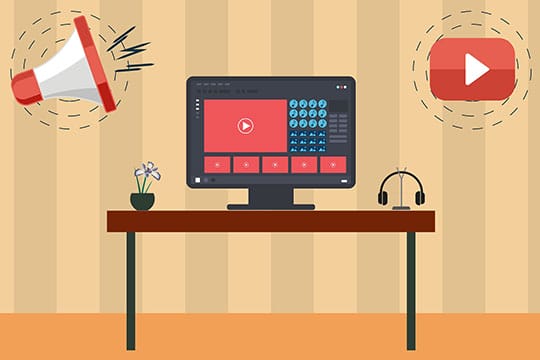The pandemic has taken over many lives and has been observed to shape new consumer behavior. As most individuals spend their time scrolling through their mobile phones or working on their laptops, the Internet has served as a window to see how everyone is coping and adjusting to the new normal.
Going all-in for digital was only a future many were looking forward to until everything moved faster than expected and planned. Thus, many business models and marketing strategies of big businesses and start-ups embraced digitization at an impressive speed. Everyone just gathered together in the digital space.
What has changed with video marketing?

Video marketing was observed to be in its phenomenal growth during the onset of the pandemic. Many businesses and video production agencies have tapped into this need. You can look at how agencies have responded to the increasing demand for video marketing.
Still, wondering how the future of video marketing looks? Here are five significant changes that shape how marketers bridge products and services with their consumers through video content amidst the pandemic and beyond.
Recommended for you: 8 Ways Digital Marketing Can Help Nonprofit Organizations.
1. Video nowadays is a must

Even before COVID-19, videos have served as a personal coach or teacher when people have to search online for an unfamiliar topic or if they have to do a new task with unknown processes. When the pandemic hit the world, video consumption became more in demand.
Video tutorials aided many individuals in discovering new hobbies and employable skills. Some people found themselves launching small businesses as an effect.
Many find recipe videos easier to absorb compared with reading blogs. Fitness videos are at the core of home workouts because fitness buffs can’t go out to the gym or run outside. A wide array of topics from DIY home decorations, stress reduction, working from home, and new dance crazes were introduced via video content.
Before, marketers treated video as just one of the many options for marketing to people. Most of the time, these weren’t even the priority because images plus captions are the usual go-to’s and seem to be an easier path to take. This strategy changed when they saw how effectively videos captured the consumer’s interest and budget. Now, many marketers are looking for ways to create waves with a strong video marketing strategy.
Videos are now getting a distinctive edge over other types of marketing communication formats. More individuals seem to prefer these over different types of content. Seeing is believing for people as videos allow them to obtain information quickly and effortlessly. Also, even marketing professionals worldwide observed that video is the type of content with the best return of investments (ROI).

2. Resourcefulness and creativity in video production

Videos used to be highly demanding of time and budget. No wonder marketers try to limit creating videos unless they’ll be used for an extensive campaign, grand product launch, or a massive movement for a cause supported by an enterprise.
However, the pandemic revealed that videos require more creativity versus a big budget. It commanded brands to make videos right now with whatever they have before they lose their audience. A whole crew of directors, producers, and cameramen equipped with professional lighting and sound systems has become unnecessary.
This traditional look of video content production has shifted to a more relaxed setting, like amateur videos that allow more room for creativity. It may look like everyone is just video blogging (vlogging), but this gives more authenticity to your brand. As long as you have a checklist to follow, your low-budget videos won’t look like promotional ads that people consider a nuisance to their online activities, which they most likely hide or skip. These videos don’t sound like selling but conversing with customers. The more laid-back the communication is, the more empathic, relatable, and human the brand appears for its niche. Therefore, there’s a higher probability that customers will prefer to connect with it.
“With social media becoming one of the central meeting places as going out and face-to-face interactions became the major limitation, businesses have tapped into its potentials. As for brands, this is an opportunity to know and engage their audience. They appear to have been in a consistent effort to satiate the audience’s hunger for entertainment, information, and connection from long-format movies or documentaries to snackable real-time content. With this, more people have developed patience in consuming video content.” – as perfectly explained by Brian Zippin, the Owner of Zipinmedia, in one of his recent interviews.
You may like: Using UTM Links in Digital Marketing: A Beginner’s Guide!
3. Real-time or interactive videos

Most likely, most employees are still working from home even after a year since COVID-19 started. It could also be possible that they tune in to live stream videos to take a break from the day’s piling tasks.
This scenario is the power of real-time content—it can successfully allow interactivity. It translates to a more engaged audience and stronger brand affinity. There are many options for live streaming sites for different niches that cater to students, business professionals, or gamers. Social media sites are usually on the top of the most popular platforms.
In the sense of revenue generation, probably the most basic form of this is the live selling you see on social media platforms. But, there’s more to this with the introduction of shoppable videos.
A shoppable video is a type of content that allows customers to access the product offering in real-time. It is almost like a brochure but in video format with a theme, story, and narrative. Customers can see all the options with the product details, just like how they’re merchandised on a website. This feature doesn’t require them to leave the current platform that hosts the video.
It’s most likely that shoppable videos shall serve as a modern selling tool convenient for customers. They can quickly check out the items they spot in the video. With online shopping and e-commerce continuing to rise, many people are now loving the comfort of purchasing products through the mobile screen and waiting for these to arrive. This phenomenon will be around for a while. In this case, videos that sell with the interactive format will be a big hit.

4. Video SEO

Getting your content to rank in Google search has gotten harder than it was three years ago. Today, there’s a lot of content optimized for Google or search engines to index and display as search results. Those websites that pioneered discussion on specific topics and are capitalizing on the power of SEO will most likely have the most advantage.
With the explosion of video, marketers can maximize the video tab in the search engine to appear at the top. The content can reach a larger audience than if they try to rank on the universal search page.
If you’re thinking of getting your videos optimized for search, here are some factors you might want to consider.
- Choose the right platform based on your objective. Think: Are you just trying to increase the brand’s visibility, or are you aiming for sales conversion?
- You also have to package your video better through a personalized thumbnail and ensure that the title and description have the relevant keywords.
- Lastly, you may also add the transcript to make it more searchable because of the additional texts. The future is leaning toward video content being more searchable.
5. AI and video marketing

Artificial Intelligence (AI) in marketing uses technologies to automate a decision based on the data analyzed and collected from a marketing effort. Artificial intelligence and machine learning can anticipate your customers’ next move and adjust to it accordingly. Using AI tools and algorithms, you can easily monitor browsing habits and improve how marketers approach each customer lifecycle. This strategy will allow you to study and know more about your customers, leading to personalized marketing.
Personalized marketing is highly essential today, and shortly, hyper-personalization will be the generation’s watchword. While engrossed in an online activity, marketers can show an ad to those audiences who previously searched for or bought the same product, related product, or even a type of discount or freebie. According to most research, consumers are more likely to buy a product after watching a video than just reading about it.
The power of AI marketing is observed to be effective in the luxury real estate market. The investment in AI video generated a higher return on investments compared with investing in traditional photography. Artificial intelligence can identify each room at the property and its amenities, layouts, design, and space of each room, and even aerial views of the property. It also tracks how the user reviews the property from which room they visited and where they stayed the longest. Noting these behaviors can help the property agent match the client’s need to an offer and highlight the best feature that attracted the most prospects.
Artificial intelligence is now an integral part of video marketing strategies that it’s now farfetched for data collection and ROI to be without it. It may even be the biggest thing in the future of video marketing.
You may also like: 5 Tips for Boosting the Marketing Strategy of your Business.
Final thoughts

They say that an average person’s attention span is just eight seconds. Video marketing can defy this when done correctly. Its power relies on how relevant the content is and how the format fits the target market.
After COVID, new video formats may keep on emerging and evolving. Changes such as the ones listed above can be inevitable. However, the question remains: How agile are you and your marketing team in adapting to this demand surge for video marketing?





